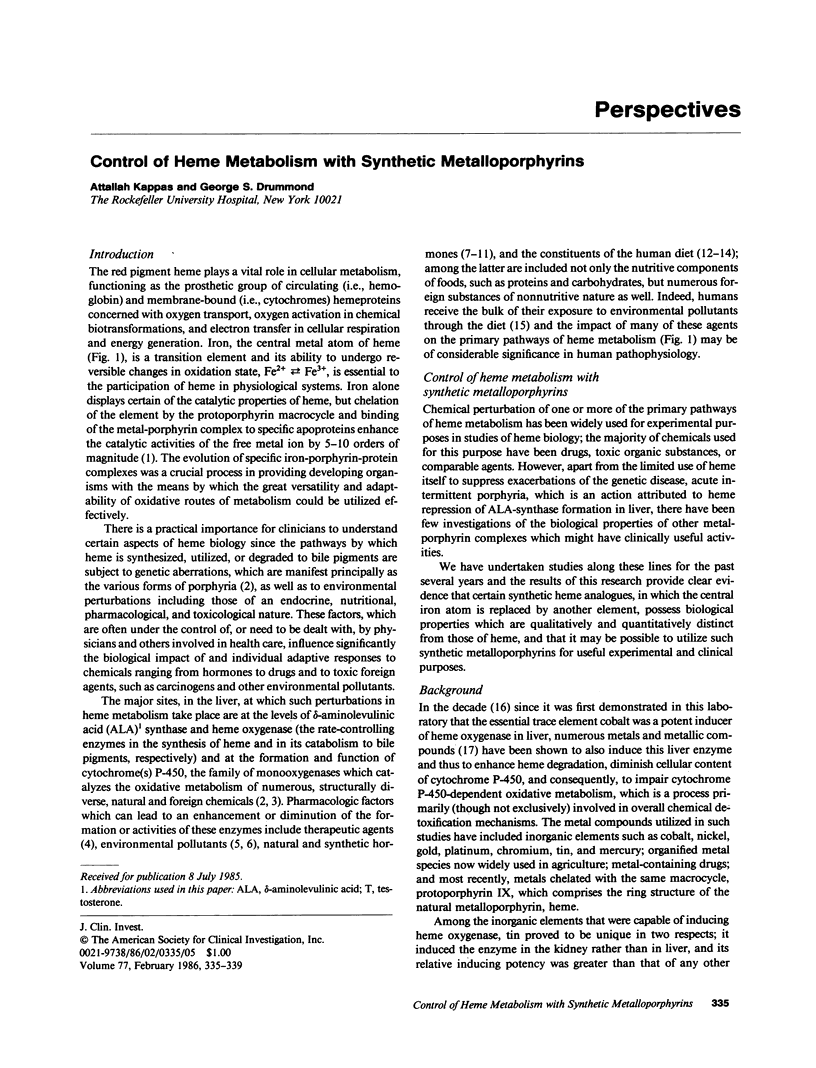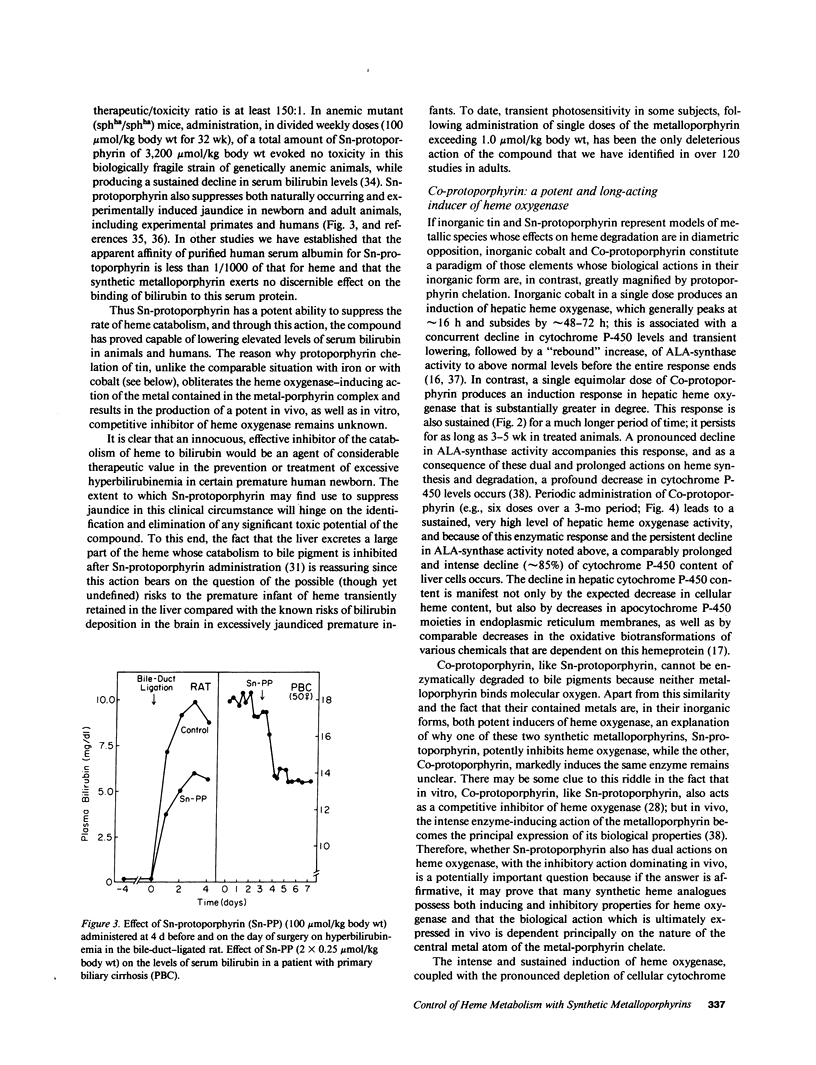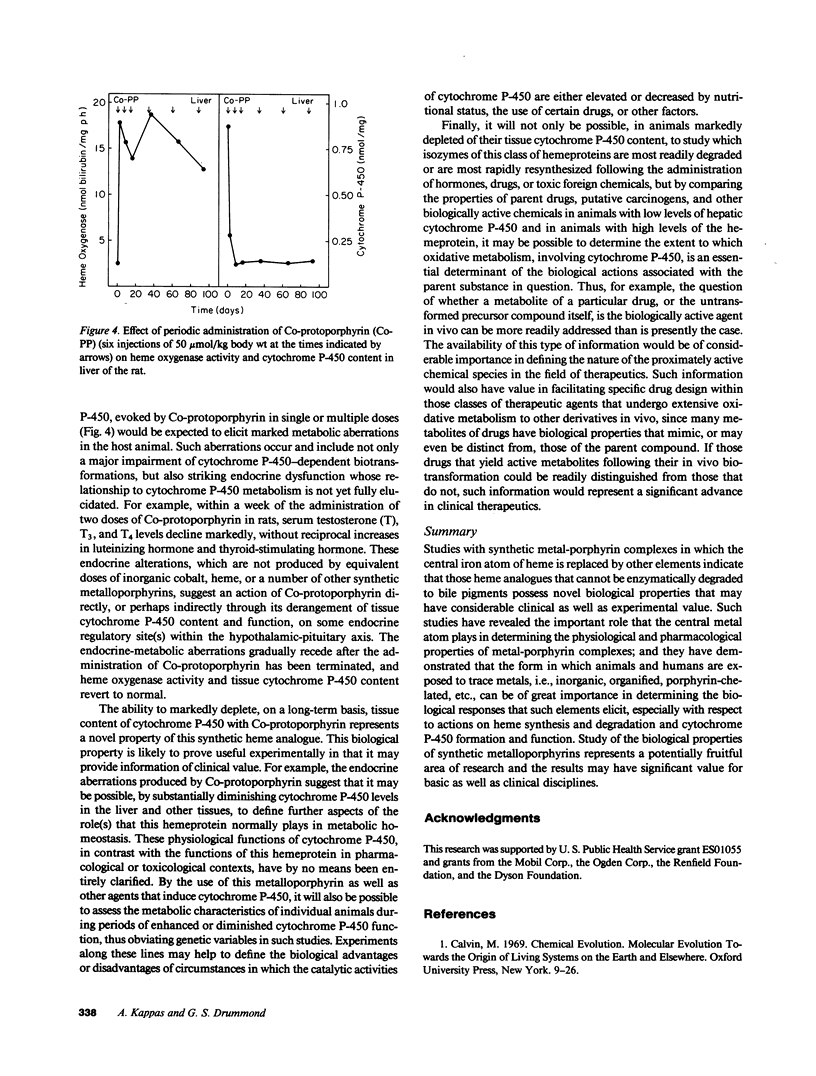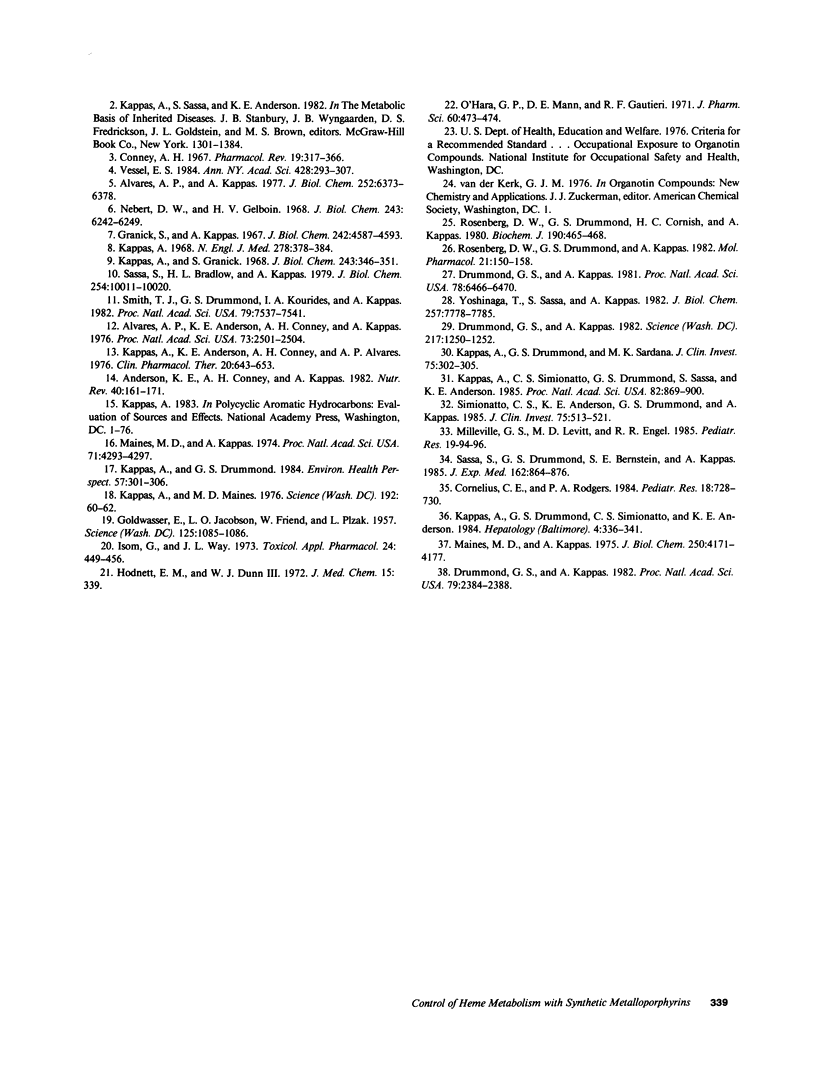Abstract
Studies with synthetic metal-porphyrin complexes in which the central iron atom of heme is replaced by other elements indicate that those heme analogues that cannot be enzymatically degraded to bile pigments possess novel biological properties that may have considerable clinical as well as experimental value. Such studies have revealed the important role that the central metal atom plays in determining the physiological and pharmacological properties of metal-porphyrin complexes; and they have demonstrated that the form in which animals and humans are exposed to trace metals, i.e., inorganic, organified, porphyrin-chelated, etc., can be of great importance in determining the biological responses that such elements elicit, especially with respect to actions on heme synthesis and degradation and cytochrome P-450 formation and function. Study of the biological properties of synthetic metalloporphyrins represents a potentially fruitful area of research and the results may have significant value for basic as well as clinical disciplines.
Full text
PDF




Selected References
These references are in PubMed. This may not be the complete list of references from this article.
- Alvares A. P., Anderson K. E., Conney A. H., Kappas A. Interactions between nutritional factors and drug biotransformations in man. Proc Natl Acad Sci U S A. 1976 Jul;73(7):2501–2504. doi: 10.1073/pnas.73.7.2501. [DOI] [PMC free article] [PubMed] [Google Scholar]
- Alvares A. P., Kappas A. Heterogeneity of cytochrome P-450s induced by polychlorinated biphenyls. J Biol Chem. 1977 Sep 25;252(18):6373–6378. [PubMed] [Google Scholar]
- Anderson K. E., Conney A. H., Kappas A. Nutritional influences on chemical biotransformations in humans. Nutr Rev. 1982 Jun;40(6):161–171. doi: 10.1111/j.1753-4887.1982.tb05298.x. [DOI] [PubMed] [Google Scholar]
- Conney A. H. Pharmacological implications of microsomal enzyme induction. Pharmacol Rev. 1967 Sep;19(3):317–366. [PubMed] [Google Scholar]
- Cornelius C. E., Rodgers P. A. Prevention of neonatal hyperbilirubinemia in rhesus monkeys by tin-protoporphyrin. Pediatr Res. 1984 Aug;18(8):728–730. doi: 10.1203/00006450-198408000-00010. [DOI] [PubMed] [Google Scholar]
- Drummond G. S., Kappas A. Prevention of neonatal hyperbilirubinemia by tin protoporphyrin IX, a potent competitive inhibitor of heme oxidation. Proc Natl Acad Sci U S A. 1981 Oct;78(10):6466–6470. doi: 10.1073/pnas.78.10.6466. [DOI] [PMC free article] [PubMed] [Google Scholar]
- Drummond G. S., Kappas A. The cytochrome P-450-depleted animal: an experimental model for in vivo studies in chemical biology. Proc Natl Acad Sci U S A. 1982 Apr;79(7):2384–2388. doi: 10.1073/pnas.79.7.2384. [DOI] [PMC free article] [PubMed] [Google Scholar]
- GOLDWASSER E., JACOBSON L. O., FRIED W., PLZAK L. Mechanism of the erythropoietic effect of cobalt. Science. 1957 May 31;125(3257):1085–1086. doi: 10.1126/science.125.3257.1085. [DOI] [PubMed] [Google Scholar]
- Granick S., Kappas A. Steroid induction of porphyrin synthesis in liver cell culture. I. Structural basis and possible physiological role in the control of heme formation. J Biol Chem. 1967 Oct 25;242(20):4587–4593. [PubMed] [Google Scholar]
- Hodnett E. M., Dunn W. J., 3rd Cobalt derivatives of Schiff bases of aliphatic amines as antitumor agents. J Med Chem. 1972 Mar;15(3):339–339. doi: 10.1021/jm00273a037. [DOI] [PubMed] [Google Scholar]
- Isom G., Way J. L. Cyanide intoxication: protection with cobaltous chloride. Toxicol Appl Pharmacol. 1973 Mar;24(3):449–456. doi: 10.1016/0041-008x(73)90051-3. [DOI] [PubMed] [Google Scholar]
- Kappas A., Anderson K. E., Conney A. H., Alvares A. P. Influence of dietary protein and carbohydrate on antipyrine and theophylline metabolism in man. Clin Pharmacol Ther. 1976 Dec;20(6):643–653. doi: 10.1002/cpt1976206643. [DOI] [PubMed] [Google Scholar]
- Kappas A. Biologic actions of some natural steroids on the liver. N Engl J Med. 1968 Feb 15;278(7):378–384. doi: 10.1056/NEJM196802152780707. [DOI] [PubMed] [Google Scholar]
- Kappas A., Drummond G. S. Control of heme and cytochrome P-450 metabolism by inorganic metals, organometals and synthetic metalloporphyrins. Environ Health Perspect. 1984 Aug;57:301–306. doi: 10.1289/ehp.8457301. [DOI] [PMC free article] [PubMed] [Google Scholar]
- Kappas A., Drummond G. S., Simionatto C. S., Anderson K. E. Control of heme oxygenase and plasma levels of bilirubin by a synthetic heme analogue, tin-protoporphyrin. Hepatology. 1984 Mar-Apr;4(2):336–341. doi: 10.1002/hep.1840040227. [DOI] [PubMed] [Google Scholar]
- Kappas A., Granick S. Steroid induction of porphyrin synthesis in liver cell culture. II. The effects of heme, uridine diphosphate glucuronic acid, and inhibitors of nucleic acid and protein synthesis on the induction process. J Biol Chem. 1968 Jan 25;243(2):346–351. [PubMed] [Google Scholar]
- Kappas A., Maines M. D. Tin: a potent inducer of heme oxygenase in kidney. Science. 1976 Apr 2;192(4234):60–62. doi: 10.1126/science.1257757. [DOI] [PubMed] [Google Scholar]
- Kappas A., Simionatto C. S., Drummond G. S., Sassa S., Anderson K. E. The liver excretes large amounts of heme into bile when heme oxygenase is inhibited competitively by Sn-protoporphyrin. Proc Natl Acad Sci U S A. 1985 Feb;82(3):896–900. doi: 10.1073/pnas.82.3.896. [DOI] [PMC free article] [PubMed] [Google Scholar]
- Maines M. D., Kappas A. Cobalt induction of hepatic heme oxygenase; with evidence that cytochrome P-450 is not essential for this enzyme activity. Proc Natl Acad Sci U S A. 1974 Nov;71(11):4293–4297. doi: 10.1073/pnas.71.11.4293. [DOI] [PMC free article] [PubMed] [Google Scholar]
- Maines M. D., Kappas A. Cobalt stimulation of heme degradation in the liver. Dissociation of microsomal oxidation of heme from cytochrome P-450. J Biol Chem. 1975 Jun 10;250(11):4171–4177. [PubMed] [Google Scholar]
- Milleville G. S., Levitt M. D., Engel R. R. Tin protoporphyrin inhibits carbon monoxide production in adult mice. Pediatr Res. 1985 Jan;19(1):94–96. doi: 10.1203/00006450-198501000-00025. [DOI] [PubMed] [Google Scholar]
- Nebert D. W., Gelboin H. V. Substrate-inducible microsomal aryl hydroxylase in mammalian cell culture. I. Assay and properties of induced enzyme. J Biol Chem. 1968 Dec 10;243(23):6242–6249. [PubMed] [Google Scholar]
- O'Hara G. P., Mann D. E., Jr, Gautieri R. F. Effect of cobalt chloride and sodium cobaltinitrite on the growth of established epithelial tumors induced by methylcholanthrene. J Pharm Sci. 1971 Mar;60(3):473–474. doi: 10.1002/jps.2600600332. [DOI] [PubMed] [Google Scholar]
- Rosenberg D. W., Drummond G. S., Cornish H. C., Kappas A. Prolonged induction of hepatic haem oxygenase and decreases in cytochrome P-450 content by organotin compounds. Biochem J. 1980 Aug 15;190(2):465–468. doi: 10.1042/bj1900465. [DOI] [PMC free article] [PubMed] [Google Scholar]
- Rosenberg D. W., Drummond G. S., Kappas A. The influence of organometals on heme metabolism. In vivo and in vitro studies with organotins. Mol Pharmacol. 1982 Jan;21(1):150–158. [PubMed] [Google Scholar]
- Sassa S., Bradlow H. L., Kappas A. Steroid induction of delta-aminolevulinic acid synthase and porphyrins in liver. Structure-activity studies and the permissive effects of hormones on the induction process. J Biol Chem. 1979 Oct 25;254(20):10011–10020. [PubMed] [Google Scholar]
- Sassa S., Drummond G. S., Bernstein S. E., Kappas A. Long-term administration of massive doses of Sn-protoporphyrin in anemic mutant mice (sphha/sphha). J Exp Med. 1985 Sep 1;162(3):864–876. doi: 10.1084/jem.162.3.864. [DOI] [PMC free article] [PubMed] [Google Scholar]
- Simionatto C. S., Anderson K. E., Drummond G. S., Kappas A. Studies on the mechanism of Sn-protoporphyrin suppression of hyperbilirubinemia. Inhibition of heme oxidation and bilirubin production. J Clin Invest. 1985 Feb;75(2):513–521. doi: 10.1172/JCI111727. [DOI] [PMC free article] [PubMed] [Google Scholar]
- Smith T. J., Drummond G. S., Kourides I. A., Kappas A. Thyroid hormone regulation of heme oxidation in the liver. Proc Natl Acad Sci U S A. 1982 Dec;79(23):7537–7541. doi: 10.1073/pnas.79.23.7537. [DOI] [PMC free article] [PubMed] [Google Scholar]
- Yoshinaga T., Sassa S., Kappas A. Purification and properties of bovine spleen heme oxygenase. Amino acid composition and sites of action of inhibitors of heme oxidation. J Biol Chem. 1982 Jul 10;257(13):7778–7785. [PubMed] [Google Scholar]


